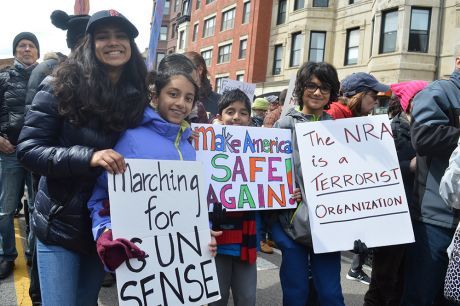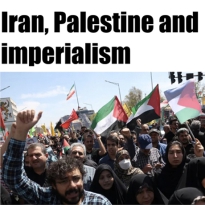Reports
You are here
March for Our Lives and America’s foundations of violence

April 4, 2018
“One child is worth more than all the guns on earth.” A woman carried this sign through the streets of Boston on an overcast afternoon. On March 24, 2018, she and millions like her marched to demand increased gun control in the United States. This mobilization was sparked by the school shooting in Parkland, Florida in February that left 17 people dead, mostly children. “We’re marching because we’ve had enough of the gun violence in our country. As a group, together, we feel that we can accomplish something,” said Declan, a 14-year-old marcher speaking with Socialist.ca. Declan and his four friends believe more in mobilizing than elections, saying “there’s strength in numbers.”
Satellite marches were held in hundreds of cities with millions marching across the US and around the world. Among the central demands of the protesters was to increase the legal age of purchase to 21, a federal ban on assault weapons (which once existed but expired in 2004 and was never renewed), and closing of the gun-show loophole which allows many people who are otherwise ineligible to purchase guns at trade shows.
Right to bear arms?
The National Rifle Association (NRA) and the Republican Party were the biggest antagonists at the march. Speaking with Socialist.ca, historian and podcaster Edward T. O’Donnell discussed the origins of the Second Amendment while carrying a sign reading “Historians Against History Repeating Itself”. O’Donnell says that at the time the Second Amendment was written, the purpose of was in large part to control slave uprisings. The Amendment states that “a well-regulated Militia, being necessary to the security of a free State, the right of the people to keep and bear Arms, shall not be infringed.” Anxieties about slave revolts disrupting the “security” of the slave-owning states led to calls for “a well-regulated militia” in the form of slave patrols.
But the right to bear arms has not been applied equally. When the Black Panthers called for armed self-defense, and organized their own militias for “police patrols,” the state did not uphold their Second Amendment rights but violently attacked them. The state has both curtailed the use of guns by oppressed communities to for collective self-defense from police violence, and encouraged the sale of guns for the individual defense of private property—encouraged by racism.
NRA videos about “freedom loving” Americans having “no choice” but to stand up and fight pander to the disproportionately poor white male gun owners who are contending with marginalized groups finally getting some representation in society. With political elites unable to help any of them, the NRA (like the MRA, “men’s rights activists”) captures these anxieties and translates them into violence.
America’s foremost cultural export, film, is sent around the world with the simple message: we understand stories only if they advance through violence. Large segments of blockbuster Hollywood films are indistinguishable from videos of war or terrorist attacks, especially in films marketed to children. And of course, you can purchase models of these death machines when you leave the theatre.
With guns intertwined with US economic and political structures, the solutions proposed from the top have universally failed. A federal assault weapons ban in 1994 - which was written with a 10 year limit by Bill Clinton and supported by ex-Presidents Ronald Reagan, Gerald Ford, and Jimmy Carter - had little effect on crime, according to the Center for Disease Control. It did, however, lead to a skyrocketing of the price of these weapons before the ban was enacted. Additionally, the ATF cited that the 3 per cent decrease in assault weapons involved in crime in this period was likely due in part to the emergence of copycat weapons intended to dodge the new regulations. In 2015 Democrat Ed Markey introduced “smart gun” legislation, attempting to circumvent America’s gun violence epidemic by implementing “personalization technology” onto firearms. This type of technocratic half-measure represents the majority of the conversation around gun violence in America. The logic here is the same as the extremist NRA that Markey and his colleagues oppose: if the right person is using a gun, then everything is okay. The implication is that 30,000 people in the US are killed annually because people are misusing others’ property.
State violence at home and abroad
One also must question why it takes tragedies like the Parkland shooting to pursue action, and why Black activists who have been calling for similar gun control remedies for a long time have been ignored. The difference between Black Lives Matter and allies calling to disarm the police and the March For Our Lives demands is that the former challenges the logic of violence at the hands of the state itself. This is not a conversation the press wants to entertain, and the Democrats would prefer to sidestep these issues and channel the momentum of the march into their electoral ambitions. But the size of the march and the movements that preceded and informed it—from Black Lives Matter to the Women’s March—can connect the anger at gun violence to the system that produces it.
Americans need to confront the fact that this epidemic goes beyond special interest groups, “lone wolves”, or intersections of gun violence and other criminal activity. There is an obsession with violence itself, driven by US imperialism. “We have a culture of violence in this country. We make war on the world,” said a veteran with Veterans for Peace speaking with Socialist.ca at the Boston march. “We make war on our own citizens. We lock ‘em up. This is the lock ‘em up capital of the world.”
A wide array of groups came to show support for the students leading the march. A large contingent from United Steelworkers Local 8751, Boston’s school bus drivers, endorsed and attended the march alongside the Massachusetts teachers union, custodians, painters, and many others. “We want to put our bodies out on the street to, as we say, walk the walk, not just talk the talk,” said Stevan Kirschbaum, Vice President of the local. Kirschbaum sees the role of organized labour as central. “We’re a union that’s a 98% immigrant union. Our kids go to these schools...we live in a country right now where violence is the culture. The Pentagon is the culture. This military parade that Trump obscenely will be conducting could fund just about every school system in the country. The moneys should be placed for human needs. Not war.”
Register now for Join the Resistance: Marxism 2018, a two day conference April 27-28 in Toronto, including the sessions “How do we stop the far right” and “The fight against racism”
Section:










